Subscribe & Listen: Apple Podcasts – Spotify – YouTube
Running a social enterprise, let alone marketing a social enterprise, is inherently more difficult.
You, as a social entrepreneur, have set your standards higher.
Achieving a profitable business model isn’t enough.
You’ve also determined to use your business as a force for good, to make an impact.
Whether you’ve determined to address chronic and systemic inequality, or the greatest environmental problems of our time, you’ve set your sights on a business model that’s about much more than doing business as usual.
And that’s why we want to see you succeed, get found online by potential customers and advocates of your brand, and accelerate the change you are looking to make in your industry and within the lives of your customers.
At Grow Ensemble, we’ve developed a Framework, a step-by-step marketing system built specifically for growing successful social enterprises and purpose-driven businesses.
This has come from my own work, where I took up digital marketing on the side in college, to starting my career in a digital marketing agency where I eventually became the CEO. At the time, I supervised nearly 100 client accounts, now, with Grow Ensemble, we produce a weekly podcast that has grown in listenership 289% year over year as well as a blog, that has helped increase our website traffic 267% over last year.
In efforts to accelerate this movement of social entrepreneurship and sustainable business, we help our purpose-driven clients to do the same—build their audiences online, compete and beat other traditional profit-centric businesses in their marketplace, all using our now tried and tested Grow Ensemble Framework.
And that is in part our goal for this post as well, to help you and your social enterprise get a game plan for marketing and messaging both your brand and mission online to build an audience of customers and advocates, to advance your impact even further (online and offline).
In this post we’ll start by outlining and introducing the principles that underlie this strategy, then we’ll dive deeper into each phase so you can get a sense for doing them yourself.
The Digital Marketing Strategy for Social Entrepreneurs & Triple Bottom Line Businesses: The Grow Ensemble Framework
The Grow Ensemble Framework is the digital marketing plan built for social enterprises and social businesses.
We’ve engineered this framework to balance the unique challenges of social entrepreneurs and change-makers who want to find a way to use their marketing messages to both drive profitable growth for their business and accelerate the impact they wish to make in their industry.
This system employs creating content (like blogs, podcasts, or videos) to build an audience around your better-for-the-world business and mission in the digital world.
In a nutshell, here’s how it works:
1. You identify your target audience and their interests as it relates to your business—both your mission and products/services.
2. You create valuable pieces of content—either blogs, podcasts, videos, or even Tweets that address these interests. Specifically, what questions and problems your audience might be having.
3. Through publishing, promoting, and distributing that content, you give potential customers the opportunity to discover your brand, learn from and connect with you, and ultimately take greater action to support your business and mission.
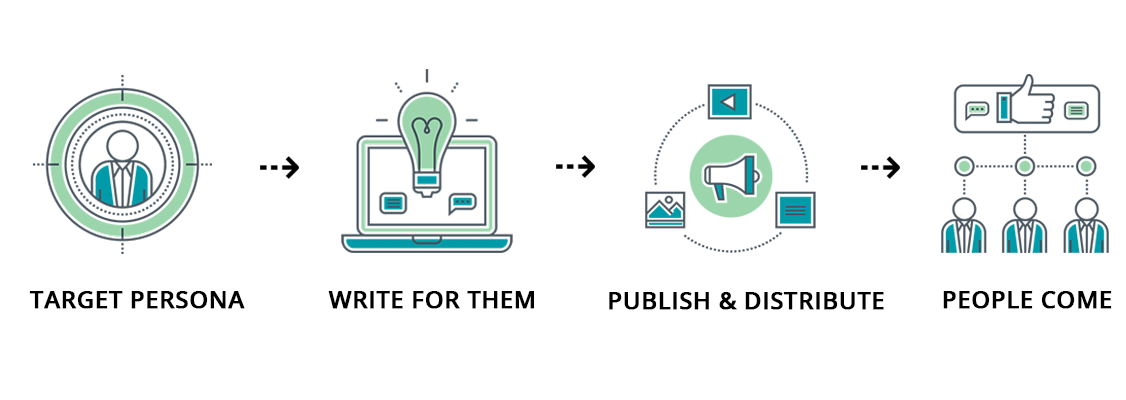
Core Principles of The Framework & Marketing a Social Enterprise
Before we dive deeper into the Framework, let’s first cover the principles that led to it’s development.
#1 — We Lead with Content (Useful & Engaging Resources for Your Audience)
First off, “content” can be so many different things. A “piece of content” can be a social media post, it can be a blog post (like this), or a podcast (like the one we recorded for this post), or a short video.
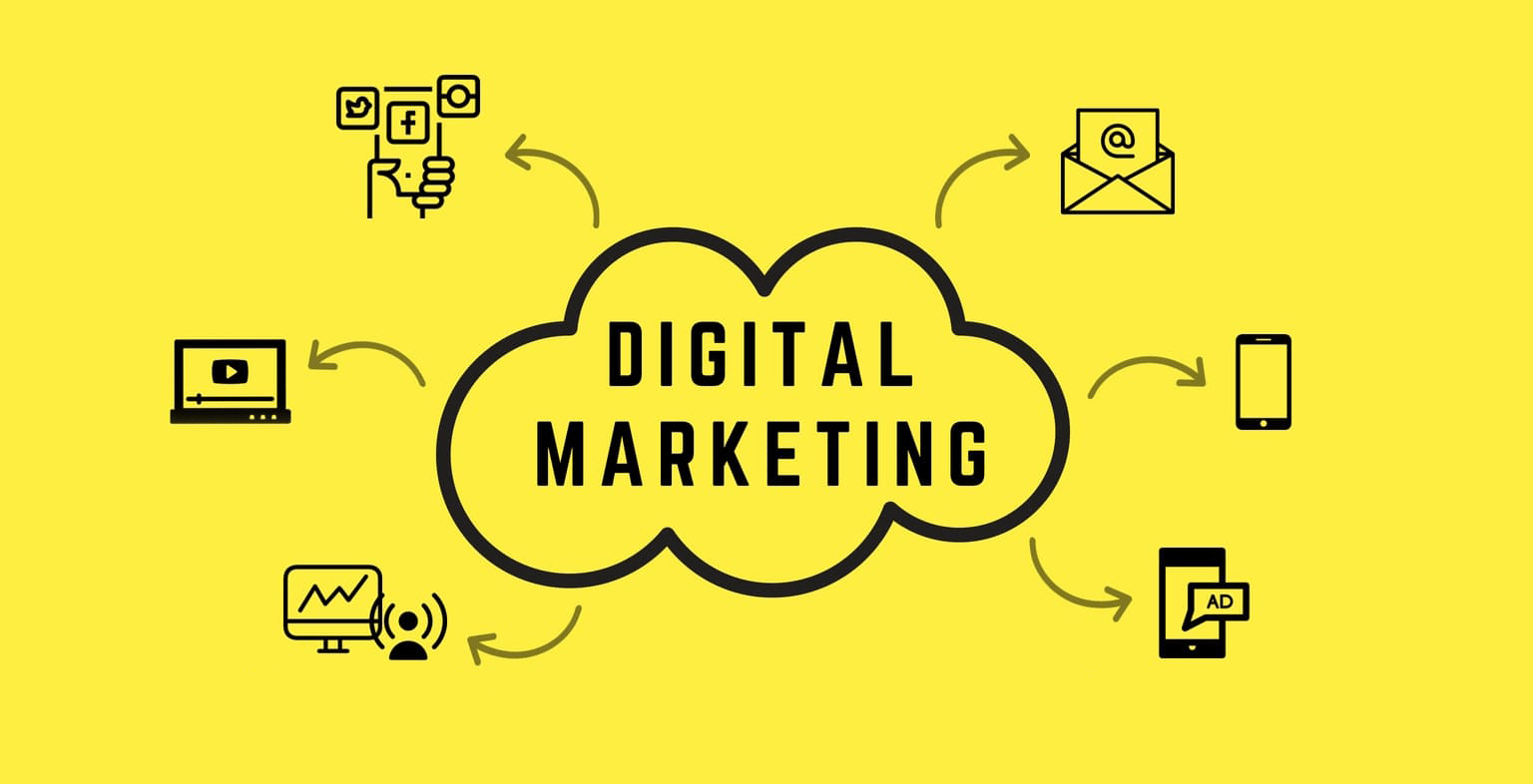
Content drives traffic and attention without any “hard selling.”
Content provides you the opportunity to build a relationship with your potential clients, customers, and advocates.
Content converts readers, listeners, viewers, into customers, clients, and advocates for your brand and mission.
We love to lead our marketing strategies with content, because it gives us an opportunity to provide value to our potential customers and clients first, versus asking them to “buy our thing!”
#2 — We Want to Be Effective.
An effective marketing strategy entails being as resourceful and clever with all the marketing efforts we are making.
We don’t want to duplicate work, and of the work we do, we want to make sure we get the greatest use of it.
For example, we’ve collected hundreds of hours of interview content for The Social Entrepreneurship & Innovation Podcast.
Do you think we just publish the podcast with our guests and that’s it?
Of course not! How many great quotes do you think there are in a 50-minute interview? Do you think our entire audience on every single platform has heard every minute of every one of our podcasts? No way!
That’s why we repurpose our content and redistribute it. Forever and ever and ever.
Not to mention, we are also creating things that we believe are relevant not just today, but will be relevant a year from now, or perhaps even 5-10 years from now.
While not always possible, we want everything we create here to have longevity. If it’s still useful, we can perpetually promote it, promote it, and promote it.
On Instagram we take quotes out of episodes and make graphics like this:
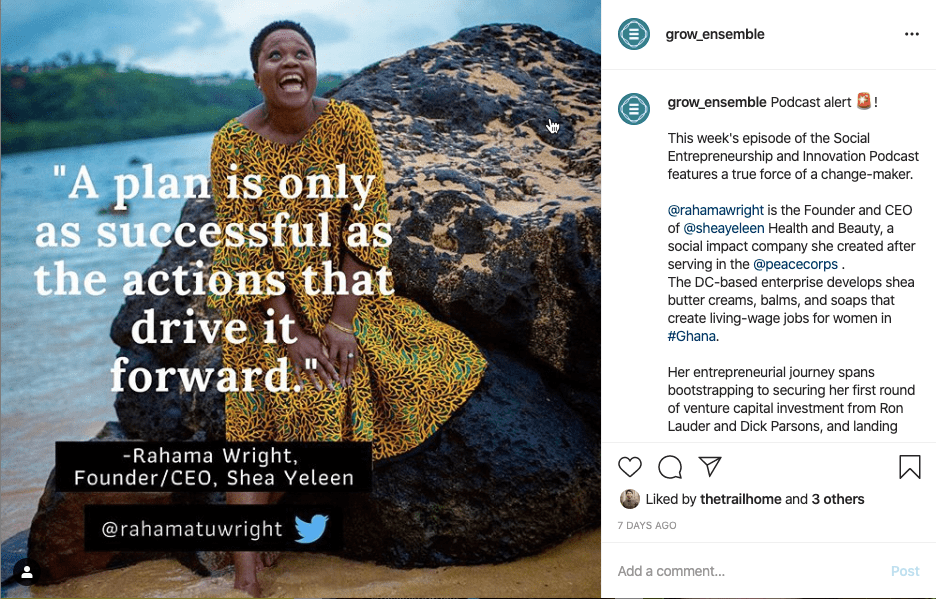
On LinkedIn we publish video shorts to promote and highlight existing podcasts like this:
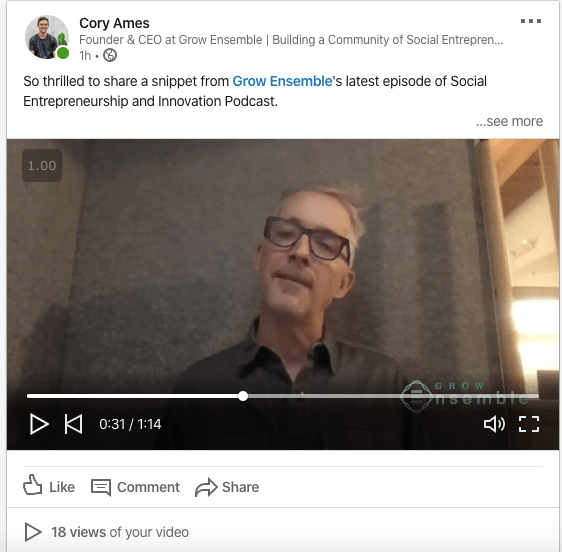
Over email, we excerpt posts we have on our blog and share them via our Better World Weekly:
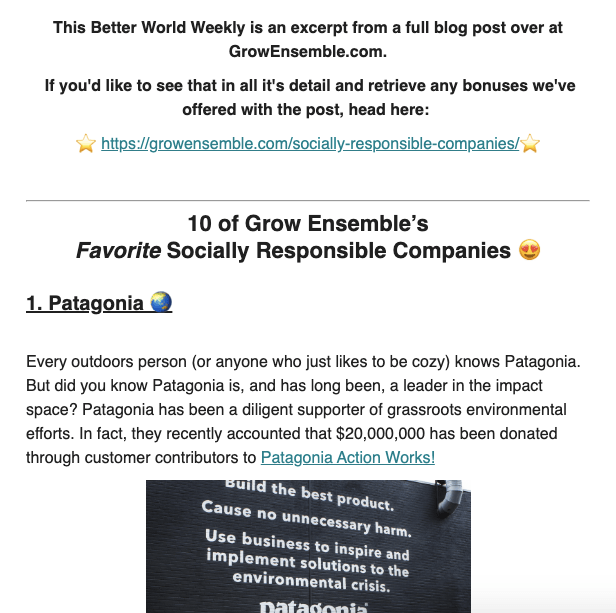
#3 — We want to be Consistent and think Long-Term.
With one of our better-for-the-world clients, All Good Products, we created a blog post for them around one of their cornerstone ingredients, Calendula.
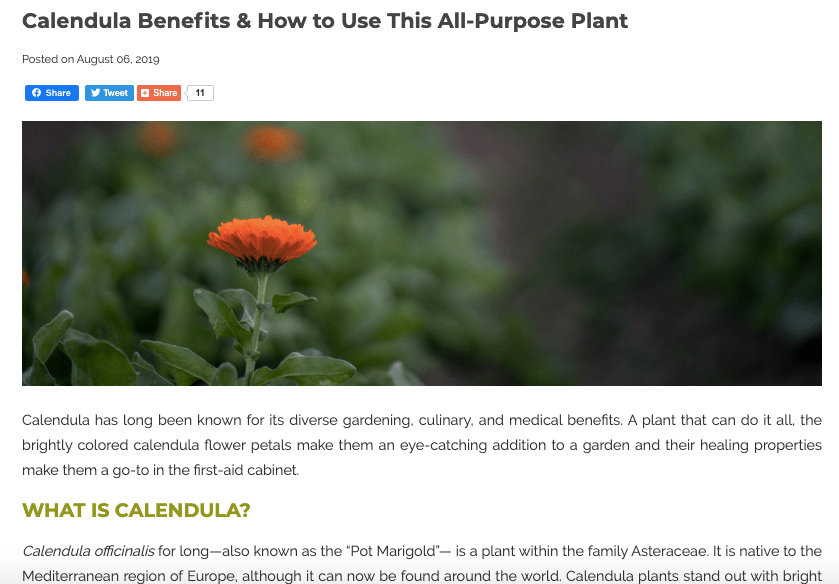
As of publishing this article (the traffic may have increased since), this post drives almost 2,000 monthly visits to All Good’s website, from Google alone! Just Google!

In the shot above, you’ll see under the column labeled “Value,” the number $1,536. That value is telling us what you would have to pay via Google’s Pay-Per-Click Ads to receive the equivalent amount of traffic and attention.
Nearly $1,500 per month and $18,000 per year!
Can you imagine if you created 52 posts like this per year? Here at Grow Ensemble we are striving to get our blog production up to 2-3 posts per week. Over 100 posts per year.
If every post was driving the equivalent of just $1,000 in equivalent ad spend per month, that would be $100,000 per month for 100 posts. $1.2M per year!
That’s why we like to call our blog posts, “Traffic Assets.” With a long-term focus in mind, the pay off becomes greater and greater.
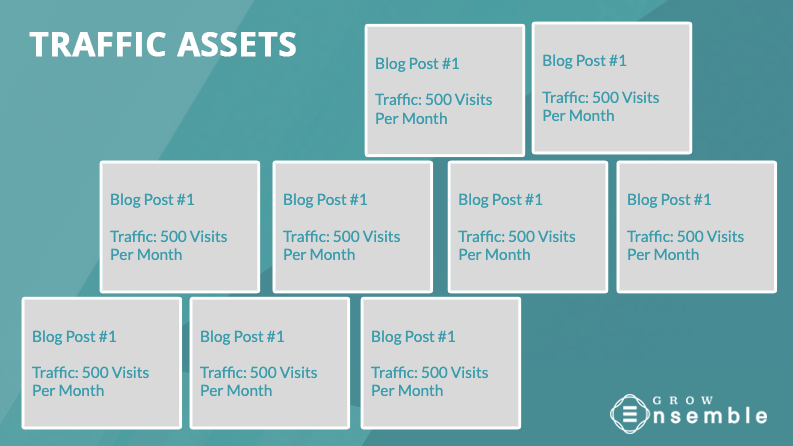
But! This only comes with consistency. Fade away from producing content, and you’ll see your “returns” fade too. Audiences like consistency! When do you release a new podcast? When can they count on the latest blog?
#4 — We want to invest in our own Platform.
Clients always ask us questions like, “What about Facebook?” “Should we be on Pinterest?” “Which social media platform should we be on?”
These are all good questions of course. But, my answer isn’t usually something folks expect.
Be on all of them you can.
But! Do everything you can, to drive people off those sites to yours.
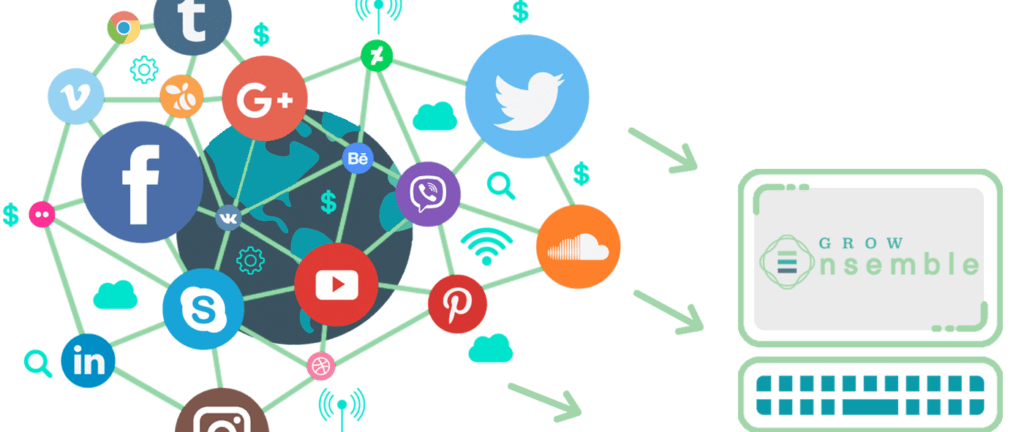
The issue is, you don’t own your Facebook followers, Mark Zuckerberg does. You don’t own your Twitter followers, Jack Dorsey does.
Ultimately, those platforms will change. And, you can assume they’ll change in favor of their interests. Not yours.
For example, you’ll often hear digital marketers say that to get the same organic reach on Facebook that you did 5-10 years ago, you have to pay.
Of course you do. That’s how their business model works. They capture attention and they sell it, and most ideally for them, at a higher and higher price.
You can expect all these social media platforms to become that way. You can expect Google to shift that way, YouTube, Snapchat, whatever.
Our philosophy here at Grow Ensemble is, leverage each of those platforms for the time being, but don’t become dependent on any one of them.
We are on Instagram. We are on LinkedIn. We are on Twitter. We are getting on Pinterest and YouTube.
We’ll use those platforms for our benefit while we can, but we want to focus on how we can drive people back to GrowEnsemble.com, and how we can keep in touch.
For us, we’ve found the best way to do so is an email list.
This is why you’ll see people like Warby Parker run website visitors through a quiz to find the best frames for them in exchange for an email.

Each social media platform is a different marketing channel for your website. Use them to your benefit while you can, but count on them to change.
Key Metrics & Tracking
The success and failure of your digital marketing strategy doesn’t need to be wildly complicated.
We are often getting asked, “what numbers should we track or be looking at for our online performance?”
Don’t overdo it. Our efforts need to be measurable, and our goals of course achievable, but keep everything simple.
When working with our clients, and for our internal systems we focus on:
1. Website Traffic (Sessions)
2. Email List Subscribers
3. Sales/Conversions *This varies on the type of business
We’ll look at our website traffic in Google Analytics. And, we’ll keep tabs on our Email List Subscribers in ConvertKit, our Email Marketing Service.
The 6-Step Digital Marketing System for Social Enterprises & Purpose-Driven Businesses
Our Grow Ensemble Framework is split between two phases, focusing on the Foundation, and then Publishing. We’ll cover each, with the individual steps, in order.
Phase 1 (Steps 1-2): The Foundation
The foundation of any successful digital marketing campaign begins primarily with two things:
1. Your strategy
2. Your website
That’s what we want to cover in the first two steps of our Framework. We need to make sure your foundation is sound before we attempt to add anything additional on it.
It won’t matter how nice the art is on your walls if your living room floor is falling through.
Step #1: Strategy: Building Your Traffic + Impact Plan
First things first, we have to know where we are, and where we are trying to go. For us at Grow Ensemble, we are conducting internal audits consistently—every 3-6 months.
Our strategy stays relatively the same, but we consider edits and revisions in roughly the same cycle, with more intensive annual reviews.
This is where we begin with any of our client engagements. This is also a 1-off service we offer, completing a complete strategy build and in-depth audit, our Roadmap Builder (book a call if you want to learn more).
In these audits and strategy builds you need to cover a few things:
- Your audience & objectives
Of course, if you are starting from scratch with your digital marketing this will be different versus having some sort of foundation.
We need to determine who your potential customers are, or who your target audience is.
This is traditionally called persona research.
Think specifically of who you are trying to appeal to with your content, if you can, get as specific as an individual person.
Who are they? What are they like? What are their interests? What might they be reading for work? What might they be reading and interested in “at home?”
Build a clear understanding of who you are trying to target. Then, we can move on to more specific research.
- Competitor & market research
With your audience in mind, you’ll need to move on to taking a look at where they are already “hanging out” online.
What are they already reading? What websites are they already visiting? Who might be serving the audience that you would like to appeal to? What newsletters are they subscribed to?
Take notes down as to what these different sites are covering, where the overlap might be with you and your audience, and what seems to be their most popular articles.
If you can get extremely specific on the target audience, as in actually being able to name an individual person, you can review their Twitter, LinkedIn, and other social profiles to see what articles they are sharing or topics they are posting about.
Be highly attentive and take note of everything you are observing.
At this point, you should have:
- A clear outline of who your target audience is (hopefully with a specific person as an example!)
- A list of the different media, publications, and websites your audience is already consuming and visiting.
- And, a list of topics and clear interests of your target audience that overlap with your business and what you want to be an authority on.
Now, let’s take all this raw material for what you might start creating content around and dig through some data.
- Keyword Research — Validate Ideas with Data
This is the final piece to building out your content strategy. We want to take all the content ideas and topics we developed from diving into our audience and market, then attempt to validate those ideas with data.
In the world of SEO (Search Engine Optimization) this is called
By conducting keyword research, we can test to see what actual interest and demand there is for our potential content ideas online.
For keyword research we like to use the tool, Ahrefs, but of course it is a paid option.
Some keyword research is better than nothing. So I’d highly recommend at a minimum finding a free tool that works for you.
Ahrefs has a great post outlining many of these options for you.
Use your content ideas and topics as the seeds, to see what sort of tangible demand exists for those terms online. These tools will also provide you with suggestions for terms and phrases more commonly searched.
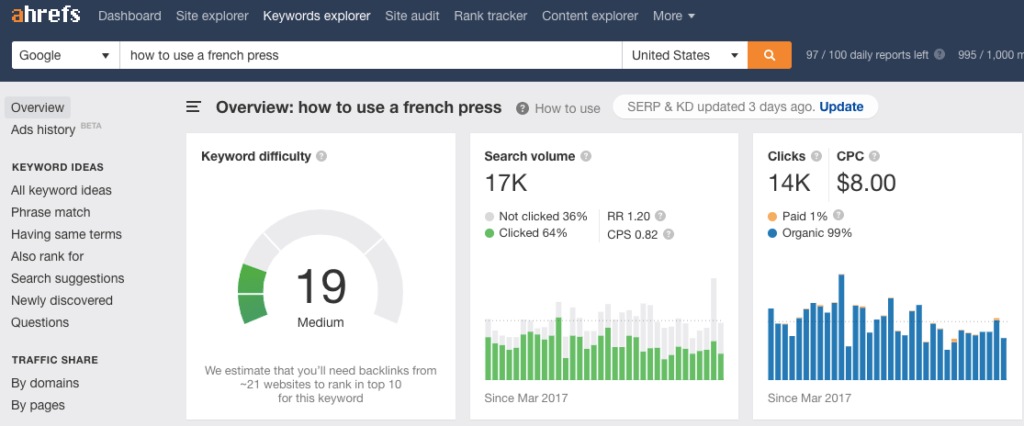
This is a critical step. In doing this sort of research we can set ourselves up to create content that we know people are interested in.
*Bonus* Audit Your Website’s Performance
Don’t forget, no matter how great your blog posts, if you site can’t load quickly and efficiently no one will read it!
These are items that we audit in our Roadmap Builder service. We check the load speed, mobile usability and onsite engagement, amongst many other potential technical issues that might hold our clients’ sites back from traffic and digital success.
You can use GTMetrix for testing load speed, Google’s Mobile Friendly Test for mobile responsiveness and generally, you should be seeing 5-10% of your total website users converting to email list subscribers.
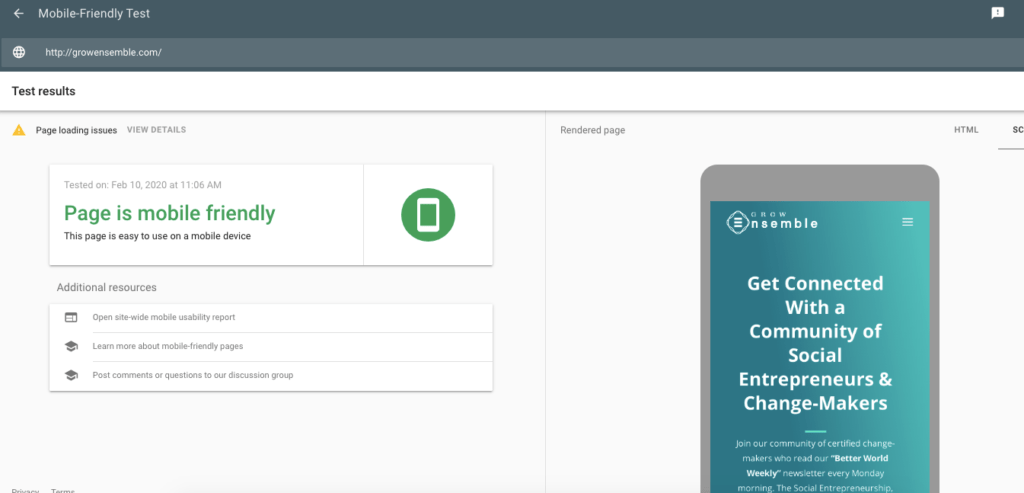
Step #2: Capture Low-Hanging Fruit: Optimize Your Foundation
With what’s uncovered in your audit, you’ll want to have the necessary technical fixes implemented.
Whether that’s optimizing the site for load speed, or having some content re-written for important product or service pages, we like to have those items tackled first.
This is a great way to capture some more traffic, or conversions fast.
For example, in partnership with our friends at LOACOM, we optimized and refreshed the website for Sustainable Wine Tours.
This included fixing some technical glitches, reviewing the site speed, and refreshing old pages.
Their total traffic jumped by 47% year over year and their sales jumped over 94%!
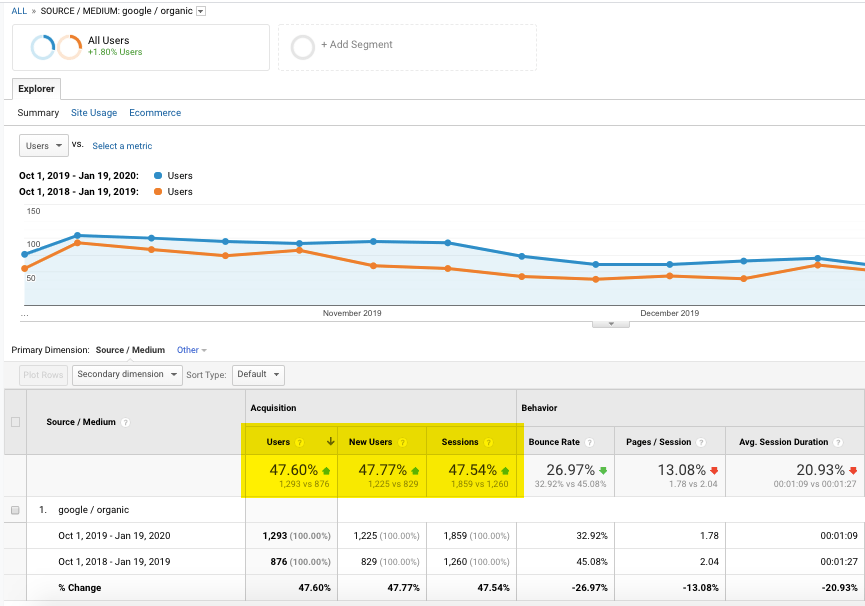
This is a great example of our priority in being effective. Always attempt to save effort and salvage previous work by making the most of what we already have at our disposal.
Phase 2 (Steps 3 – 6): Build & Run the Content Machine
With the foundation established—both a sound strategy and an optimized base (your website), you are ready to start adding fuel to the fire with an audience-building content production process.
Step #3: Content Production
It’s one thing to build the strategy, it’s another thing to actually build the system for producing content consistently and reliably.
To go from “strategy” to “execution” here’s what needs to be considered:
- Team —
While many CEOs and Founders say they’ll produce content themselves (Annie and I included!), you don’t want your consistent publication 100% dependent on you!
From supporting writers (at Grow Ensemble we have great show notes writers for our podcast and a team of contributors for our blog), to content editors, to developers and designers to help publish, a system is essential to ensure that your content efforts don’t fade.
For our clients, we’ll work to source and train writers with industry-relevant know-how (or the willingness to really learn).
Then our internal team of designers, developers, and editors help the content actually “go live.”
- Quality —
Of course “quality” is a subjective measure. However, if we are producing crap content (blogs, podcasts, etc.) then our whole strategy falls flat.
For our content to have the greatest chance of organic discovery, we have to attempt to create the “best piece on the internet” for any topic we are writing about.
While difficult to measure exactly, these are horizon lines that we must strive for. High-quality content is a must!
- Consistency —
Again, as mentioned earlier, a key to success with our framework is consistency. And, in the realm of production, we have to make sure we have the systems and resources at our disposal to ensure we are publishing consistently.
Our recommended minimum for this strategy to see significant results is one piece of content per week.
However, if you can’t get there right away, get started where you can—once a month, or every other week. But set the goal to increase production.
Step #4: Google & User-Friendly Publication
With a team in place and the systems established for producing your content consistently and reliably, you’ll want to consider the following for how things look when “published:”
- Usability, Engagement, & Searchability —
Whether we are publishing a show notes page for our podcast, or a 5,000+ word blog post about social entrepreneurship, we’ll want to make sure the content is as easy to read for both our users and Google as possible.
Is the page easy to review and presentable on both desktop and mobile devices? Do we know if we are following OnPage SEO best practices? Is the page built to make it easy to both read word for word or scan?
Are there engaging and unique visual elements? Custom graphics, or unique relevant photography?
These are important elements to make sure that the excellent post or podcast we published actually gets consumed.
A basic, but often undervalued step of the content process!
Step #5: Promotion & Distribution
Promotion and Distribution are truly never-ending pursuits. Especially if we are following the early mentioned principle of thinking “long-term” and creating content that has longevity. Ideally, we should be able to promote our content forever and ever and ever.
I recommend not complicating things here. Ideally, with time, our posts should capture traffic from Google (via SEO). That’s great, and that can provide us a compounding source of traffic we can depend on.
Otherwise, you can send updates of your new content out to your email list. Each week we publish our Better World Weekly, where we often excerpt our blog posts or recap a podcast episode.
Of course, we also distribute via social media. As noted before, we like to do this creatively, with repurposing and distributing our content in ways that will be most engaging for the different social platforms.

Again, don’t get too complicated to start, here. Find what channels are easiest for you to promote to first, and see how those go.
But once again, a key element here, think about how you can invest in your own platform. That’s why with all our social activity and distribution we want to drive people back to our own site.
There are many others to consider later on:
- Paid Ads (Google PPC, Facebook, LinkedIn, Twitter, etc.)
- Additional Owned Channels (for instance, we are very happy to republish all our podcast episodes to B the Change, the B Corporation’s community blog with over 17,000 followers)
- Strategic Partnerships, Cross-Promotion
Step #6: Review & Analysis — Get Better With Time
For our own content production efforts at Grow Ensemble, we are conducting a formal analysis of the performance every 90 days.
We will use tools like Google Analytics and Ahrefs to identify:
- What content saw the greatest traffic?
- What content saw the greatest engagement? (Time on page, low bounce rate, etc.)
- What content is getting some traction in Google? (ranking for keywords)
- What content fell flat? (Didn’t perform like we would have hoped)
By taking this deep procedural look each quarter we can see which content to add or cut in our future queue, and what sort of pieces we should consider going back to revise.
If a page is getting a lot of traffic, we may even consider creating a specific opt-in to capture more email list subscribers from all the folks who have been landing on that page.
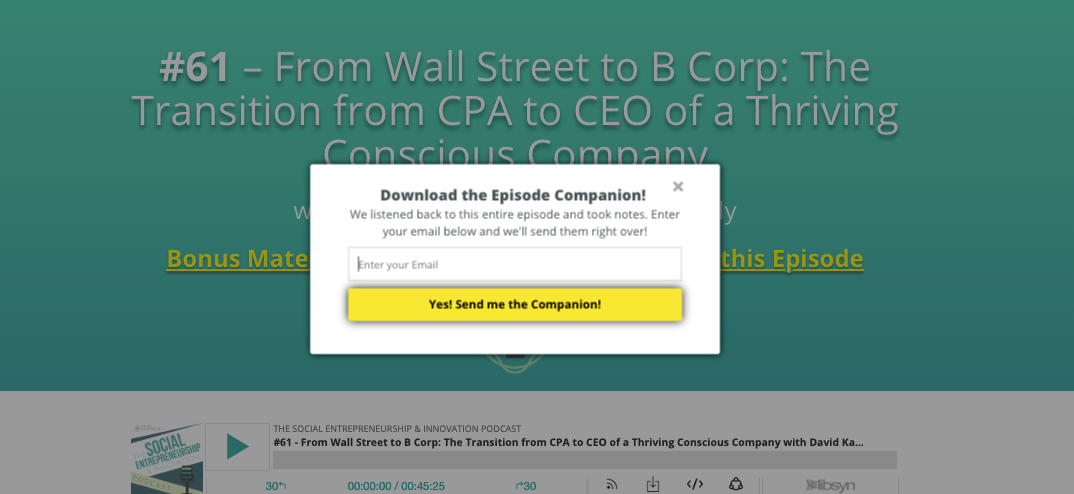
We want to find ways to provide our visitors with “extra value” in exchange for contact information
It’s this analysis that will determine our adjusted plan for the next 90 – 180 days. We execute on this same process with our clients to ensure our strategies are improving at a rapid pace.
We determine what worked, what didn’t, and where we should shift focus because of it.
Why You Might Fail
There are a million and one ways to grow and market a social enterprise in the digital world.
The key is to stick with one strategy for long enough to refine it, tweak the tactics, and see the results you are looking for.
However, here are the most often ways we’ll see businesses come up short in attempting to implement our methods:
- They aren’t consistent —
We can’t stress this enough. Content pays off. You put yourself in a powerful position by controlling the information space of your industry. But, if you don’t remain consistent, you’ll never allow the real fruits of this method to pay off.
Traffic compounds and authority takes time to build. But, the rewards are worth it. If you are going to do this, you’ll have to commit to it for a minimum of 6-12 months to see real traction for you and your business.
- Lacking systems —
Perhaps the #1 reason people can’t remain consistent? They didn’t build a system around their content production process.
Build a system to ensure that each week (or whatever cadence you’ve chosen) your podcast is publishing, your blog post is publishing, or your video is.
If your system is too dependent on a single person’s willpower (usually the Founder), it will ultimately fail.
- Lacking quality —
There’s a lot of content being published online. But, honestly, most of it sucks. A lot of people don’t put in the time to create a blog post or podcast that truly engages. From the UX to the material itself, you need to consider how it’s being received.
You and your team need to be making the greatest effort each and every time you publish something.
Don’t let that stop you from publishing, you can improve over time, but if you aren’t making 100% effort to go as deep into the content as possible, you won’t succeed.
Conclusion: The Social Enterprise Marketing System to Achieve Greater Social Change
We’ve constructed our Grow Ensemble Framework to see that more better businesses and better business people get found online.
We want to see that the social entrepreneurs and change-makers (in the for-profit or nonprofit sector) who are truly dedicated to using social impact business models to leave the world a better place than they found it have a louder megaphone with which to shout from.
Hopefully, this was a helpful overview of our Grow Ensemble Framework, but if you want to dive deeper, book a “Traffic + Impact Strategy Session” with me or one of our Grow Ensemble Marketing Specialists.

Cory Ames
Co-Founder & CEO, Grow Ensemble
I’m Cory Ames. I’m a writer, podcaster, social entrepreneur, and the Founder of Grow Ensemble.
Our Latest Articles & Interviews:
The Better World Weekly Newsletter
Join 7,000+ others exploring the who, what, why, and how of building a better world and sign up here.

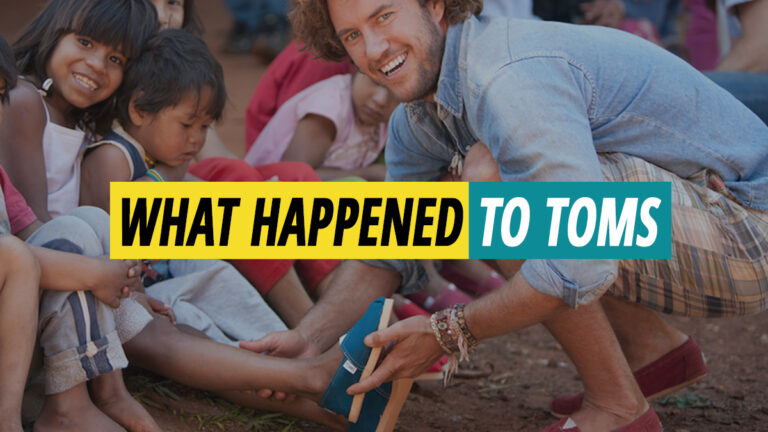

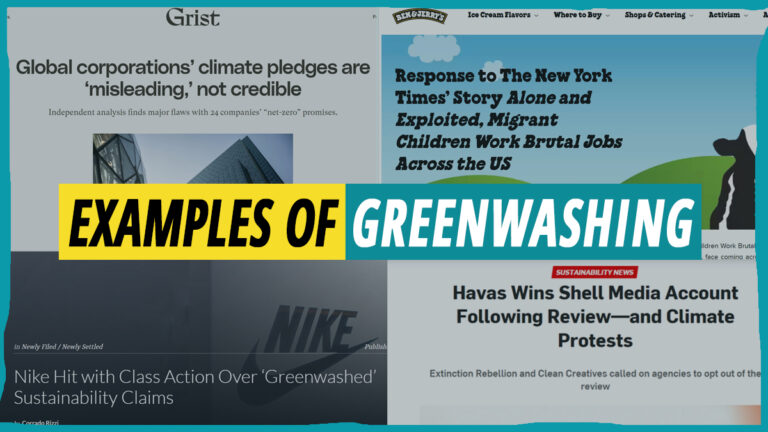
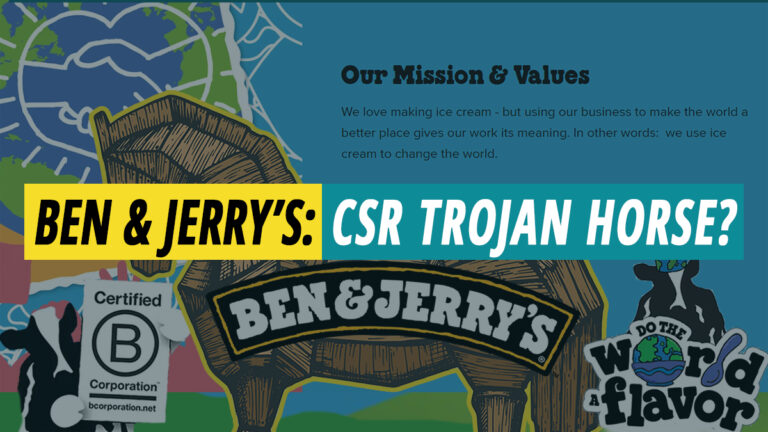

Leave a Reply